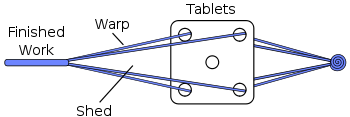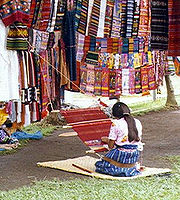
Shed (weaving)
Encyclopedia


Weaving
Weaving is a method of fabric production in which two distinct sets of yarns or threads are interlaced at right angles to form a fabric or cloth. The other methods are knitting, lace making and felting. The longitudinal threads are called the warp and the lateral threads are the weft or filling...
, the shed is the temporary separation between upper and lower warp
Warp (weaving)
In weaving cloth, the warp is the set of lengthwise yarns that are held in tension on a frame or loom. The yarn that is inserted over-and-under the warp threads is called the weft, woof, or filler. Each individual warp thread in a fabric is called a warp end or end. Warp means "that which is thrown...
yarns through which the weft
Weft
In weaving, weft or woof is the yarn which is drawn through the warp yarns to create cloth. In North America, it is sometimes referred to as the "fill" or the "filling yarn"....
is woven. The shed is created to make it easy to interlace the weft into the warp and thus create woven fabric. Most types of looms have some sort of device which separates some of the warp threads from the others. This separation is called the shed, and allows for a shuttle
Shuttle (weaving)
A shuttle is a tool designed to neatly and compactly store weft yarn while weaving. Shuttles are thrown or passed back and forth through the shed, between the yarn threads of the warp in order to weave in the weft....
carrying the weft
Weft
In weaving, weft or woof is the yarn which is drawn through the warp yarns to create cloth. In North America, it is sometimes referred to as the "fill" or the "filling yarn"....
thread to move through the shed perpendicular to the warp threads. Which threads are raised and which are lowered are changed after each pass of the shuttle.
The process of weaving can be simplified to a series of four steps: the shed is raised, the shuttle is passed through, the shed is closed, and the weft thread is beaten
Beater (weaving)
A beater is a weaving tool designed to push the weft yarn securely into place. In small hand weaving such as Inkle weaving and tablet weaving the beater may be combined with the shuttle into a single tool. In rigid heddle looms the beater is combined with the heddles...
into place. These steps are then repeated, with a different set of threads being raised so as to interlace the warp and weft.
The term shedding refers to the action of creating a shed. A shedding device is the device used to raise or open the shed. Creating the separation is referred to as raising or opening the shed, while the reverse is known as lowering or closing the shed.
Shedding device

Tablet weaving
Tablet Weaving is a weaving technique where tablets or cards are used to create the shed through which the weft is passed. The technique is limited to narrow work such as belts, straps, or garment trim....
the sheds are raised and lowered by rotating the tablets, or cards. In a floor loom the shed is created by the harnesses. Inkle looms
Inkle weaving
Inkle weaving is a type of warp-faced weaving where the shed is created by manually raising or lowering the warp yarns, some of which are held in place by fixed heddles on a loom known as an inkle loom. Inkle weaving was referred to in Shakespeare's Love's Labour's Lost. It was brought to the...
have one of the more primitive shedding devices, where there is one set of heddle
Heddle
A heddle is an integral part of a loom. Each thread in the warp passes through a heddle, which is used to separate the warp threads for the passage of the weft. The typical heddle is made of cord or wire, and is suspended on a shaft of a loom. Each heddle has an eye in the center where the warp is...
s and the shed is created by hand.

Weft
In weaving, weft or woof is the yarn which is drawn through the warp yarns to create cloth. In North America, it is sometimes referred to as the "fill" or the "filling yarn"....
was inserted into the warp by picking the warp threads up individually, as is done in tapestry weaving. After each weft thread is woven the warp threads had to be picked out and lifted again, which made the process slow. To speed up the process various devices were developed to create a reproducible shed, so that the weft could be passed between the separated threads, and so the threads would not have to be separated individually each time. The first type of shedding device was called a shed-rod. It was a rod inserted into the warp to ease in weaving, and came about at the same time as the heddle
Heddle
A heddle is an integral part of a loom. Each thread in the warp passes through a heddle, which is used to separate the warp threads for the passage of the weft. The typical heddle is made of cord or wire, and is suspended on a shaft of a loom. Each heddle has an eye in the center where the warp is...
. Threads were alternated over and under the rod, and the threads that went under the rod went through string heddles attached to a bar. The shed was created in two ways:by raising the shed-rod, and by lifting the heddles. The shed-rod was an invention of eastern origin, and was introduced to Europe via Egypt in the first century AD. The Romans used it for both plain weave
Plain weave
Plain weave is the most basic of three fundamental types of textile weaves . It is strong and hard-wearing, used for fashion and furnishing fabrics....
and twill
Twill
Twill is a type of textile weave with a pattern of diagonal parallel ribs . This is done by passing the weft thread over one or more warp threads and then under two or more warp threads and so on, with a "step" or offset between rows to create the characteristic diagonal pattern. Because of this...
.
After the shed-rod came the rigid heddle loom, where the shed is created by raising or lowering the rigid heddle. As the loom progressed, the shed-rod was replaced by a second set of heddles, for a total of two shafts with heddles. Eventually looms like the modern floor loom were developed, where there are many shafts which can be raised to create the shed.
Rising shed loom
Two different shedding methods were developed for the harness loom-one where any one harness or combination of harnesses was lifted while the other harnesses remained stationary. This type of loom is known as a rising shed loom, and examples include the table loom, dobby loomDobby loom
A Dobby Loom is a type of floor loom that controls the whole warp threads using a device called a dobby. Dobby is a corruption of "draw boy" which refers to the weaver's helpers who used to control the warp thread by pulling on draw threads....
or the Jack loom. The other method used in harness looms is where some harnesses are raised while others are lowered. The second method lessened the effort of lifting the selected harnesses because they no longer needed to be raised as high as in a rising shed loom. Counterbalance and countermarch looms are of this second type.
Poor shed
There are many things that can cause the warp threads not to separate cleanly, and thus produce a poor shed. A slack warp, threads set too closely in the reedReed (weaving)
A reed is part of a loom, and resembles a comb. It is used to push the weft yarn securely into place as it is woven, separates the threads and keeps them in their positions, keeping them untangled, and guides the shuttle as it moves across the loom. It consists of a frame with lots of vertical...
, or increase of friction on the first foot or so of the warp where the threads were handled all cause poor sheds. Fuzzy yarns like mohair
Mohair
Mohair usually refers to a silk-like fabric or yarn made from the hair of the Angora goat. The word "mohair" was adopted into English before 1570 from the Arabic: mukhayyar, a type of haircloth, literally 'choice', from khayyara, 'he chose'. Mohair fiber is approximately 25-45 microns in...
can also cause a poor shed. To get a better shed the weaver can lift the harnesses while the reed is against the fabric, or raise only one harness at a time. By weaving in a different manner sometimes a good shed can be created. The weaver can also insert a stick into the shed to clear it, and make way for the shuttle. This option is time-consuming though.

